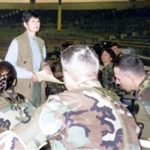By ELAINE BASSIER
Elko Daily Free Press
ELKO, Nev. (AP) _ Native American traditions may be the key to helping modern-day veterans with post-traumatic stress disorder.
Taki Telonidis, the producer for the Western Folklife Center’s media office in Salt Lake City, has been working on a documentary called “Healing the Warrior’s Heart” that explores the ways some Native American tribes treat their veterans when they return from war.
Telonidis said around two million Americans have served in Iraq and Afghanistan. Some come home fine, others have life-changing injuries and “many are coming home with invisible drama,” or PTSD.
Some tribes refer to PTSD as a wounding of the soul, Telonidis said. Part of the veteran’s spirit is still on the battlefield, and he said the tribes have traditions that can heal his or her heart.
“What they’re trying to do is bring their spirit home,” Telonidis told the Elko Daily Free Press (http://bit.ly/1enSiX4).
He said a lot of Native Americans have lost their connection to the warrior spirituality, but he is seeing a revitalization of that idea. The traditional healing methods are not only working for some Native American soldiers _ Telonidis has seen the method work for other veterans suffering from PTSD.
Telonidis is studying two specific locations for his film: the George Wallen Veteran Affairs Center in Salt Lake and the Blackfeet reservation in Montana and Canada.
At the VA center, a Shoshone-Paiute medicine man is offering sweat lodges for anyone who is interested.
“Guilt and shame are the biggest things guys bring back with them,” Telonidis said. Often, veterans with PTSD have one particular image that is frightening and they relive it over and over. Sometimes it’s the death of a colleague or friend or a memory of killing an enemy.
The medicine man instructs the veteran to bring the spirits of the people in those memories with them into the sweat lodge. Then, he tells the veterans to have the conversation the veteran has been wanting to have with them all these years. Veterans are encouraged to talk to those people and tell them how they feel, and to ask forgiveness if they feel they need to.
The sweat lodge isn’t a one-time fix. Veterans need to come in periodically and have the conversation often for the best results. Telonidis described it as a lifting of a burden.
“Just like any other therapy, you have to keep coming back,” Telonidis said.
Some find the experience uncomfortable and don’t return, but for those who do, it can be life-changing, Telonidis said. He is convinced it taps into something and heals something that other therapies don’t reach.
In the Blackfeet reservation, Telonidis is following Native American soldiers as they prepare to go to war and come back.
Historically, the Blackfeet have been a warrior culture, and the young people of the tribe are still attracted to the warrior idea. In the tribe, warriors were leaders and protectors as well as fighters. The younger Blackfeet are interested in becoming a warrior because their ancestors were warriors, Telonidis said.
Those veterans who shun the tribe’s traditions usually find the transition from soldier to citizen harder, Telonidis said. The documentary is following one young man who served several tours in Iraq and Afghanistan. He initially ignored the traditions of the tribe, and was having a hard time adjusting to being home.
A medicine man began working with him and counseling him, telling him about the native religion. Now, while he still has struggles, he believes he is in a much better place.
Telonidis said Native Americans offered to show others their traditions for healing warriors. He thought the idea first began resurfacing in 2004. Groups of psychotherapists, scholars and chaplains are studying these traditions and trying to adapt them for all veterans.
“They said, `This is our tradition … we would be interested in you offering this to at least as many non-natives as natives,” Telonidis said.
As for Telonidis’ own interest in the project, he was disturbed by the effect of war on so many people. However, he said, most Americans are able to separate themselves from the issue. He wanted to explore the problems of war using the Western Folklife Center’s vision.
The Western Folklife Center is dedicated to documenting and celebrating traditional culture. While the center usually studies cowboy culture, it is also interested in Native American culture.
“I was wondering if there was a way to combine the Western Folklife Center with this particular issue of veterans coming home,” Telonidis said.
He has researched the project for about a year and a half. Filming began in July 2013 and will be completed in late spring 2014. It’s possible the film will air on Veteran’s Day 2014. Since November is also Native American Heritage Month, Telonidis said it was the perfect combination to honor both topics in the documentary.
“Healing the Warrior’s Heart” is a Western Folklife Center production in partnership with KUED Channel 7 in Salt Lake as the PBS affiliate. Gary Robinson from Tribal Eye Productions is a partnering producer.
Telonidis is looking for funds to complete the project. Those who would like to donate can become a Western Folklife Center Stakeholder at http://contribute.westernfolklife.org/ and select the “Media Programming” designation.
___
Information from: Elko Daily Free Press, http://www.elkodaily.com










